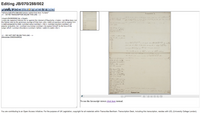CIRCA:The Bentham Project
From CIRCA
The Bentham Project began at the University College of London (UCL) in 1958 with the intent of publishing an exhaustive scholarly edition of philosopher Jeremy Bentham’s (1748-1832) writings. Bentham was prolific; when the scholarly edition is complete it will total over 70 volumes on the topics of morality, religion, crime and punishment, law, economics, and other related subjects.
Bentham’s original manuscripts, about 72,500 folios total, are challenging to transcribe. His writing is hurried and sometimes incomprehensible, there are numerous scribbles, revisions, and crossed out words, and the folio paper itself is rather large. Almost 20,000 folios had been transcribed by hand between the year of the project’s inception (1958) and 2010.The challenging nature of the work, and the public's interest in it's completion, led to the creation of interesting and diverse sub-projects that reside within the Bentham Project itself.
Contents |
Transcribe Bentham
The Transcribe Bentham Project, initiated in September 2010, received a one-year grant with the expectation that the laborious work of transcription be completed voluntarily by interested members of the online community (crowdsourcing). The grant itself was used for the creation of high quality digital images of the folios, the staffing of two full-time project coordinators, setting up the web interface, and various other administrative costs.The web interface used for Transcribe Bentham is a customised MediaWiki that hosts the scanned manuscripts, the transcription tool (a WYSIWYG type text editor), project documentation, a discussion forum, and a rudimentary social media platform that lets members and project organizers communicate.
The manuscripts were photographed at a high resolution that allowed for maximum magnification. The quality of the scanned images was vital, due to the difficult nature of deciphering the material.
A great deal of attention was payed to the encoding process. Users can select a portion of text that needs encoding (something like an unintelligible word or addition), and press the appropriate button on the toolbar. The text is automatically tagged with TEI compliant XML, preventing the user having to worry if a document ends up being well-formed. Although the practice of encoding is not required by the transcriber, it adds a valuable layer of depth to the final document and allows for searchability. It likely also provides a sense of completion for the user, especially when words are crossed out or unintelligible.
When a transcript is deemed complete by the transcription desk, it is uploaded to the UCL’s digital collection, where it can be viewed, along with the original image of the document, by anyone. The authours propose that this digitization is not only convienent for scholars, but essential for the long-term preservation of the work. The TEI compliant coding and high-quality scanning have transformed the project into a digital archive.
So far, over 2,500 users have signed up to participate. Of the 8,068 manuscripts that have been scanned and uploaded, 54% have been completed (or 4,412 pages). When complete, the images of the manuscripts and the transcriptions will become a free digital resource available to the public.
Publication of Collected Works
Since 1968 there have been 28 volumes published from the anticipated 70 volumes of the Collected Works of Jeremy Bentham. The books are available for purchase in print, but digital copies are available to students and staff of UCL.
International Society for Utilitarian Studies
The International Society for Utilitarian Studies exists to further the scholarship of the Bentham Project by organizing seminars and conferences with the aim of encouraging debate and discussion on the topic of utilitarianism.
Auto Icon
The Auto Icon, currently on display in the main building at UCL, is the preserved and clothed skeleton of Bentham topped by a wax rendering of his visage. In a will that was written shortly before his death in 1832, Bentham wrote:
- "The skeleton ... will ... be put together in such a manner as that the whole figure may be seated in a chair usually occupied by me when living, in the attitude in which I am sitting when engaged in thought in the course of time employed in writing. If it should so happen that my personal friends and other disciples should be disposed to meet together on some day or days of the year for the purpose of commemorating the founder of the greatest happiness system of morals and legislation my executor will from time to time cause to be conveyed to the room in which they meet the said box or case with the contents therein to be stationed in such part of the room as to the assembled company shall seem meet."
- Queens Square Place, Westminster, Wednesday 30th May, 1832 [1]
He had originally requested that his head be preserved and affixed to the skeleton, but the preservation was not sufficient for the head to portray an accurate representation of his face. For a time the preserved head was on display with the rest of the apparatus, but due to several incidences of theft, it has now been secured away from public viewing.
A 360-degree rotatable image of Bentham's Auto Icon is available for viewing here.


